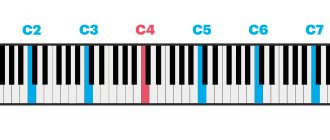We, singers, are the main instrument of the orchestra. Maria Callas
For a beginning singer, it is important to analyze the types of voices and classify your own timbre; this is not just information “for show”.
The belonging of a voice to a specific type (and these are exclusively natural data) determines the direction in which the vocalist is best to develop in order to improve his voice.
By analogy with sports: anyone can be taught to play basketball, but a tall player will always find it more convenient and easier. Also, a natural tenor confidently works with high notes, while a baritone has a much more difficult time with them. Correct identification of your voice will allow you to create an individual program for vocal lessons and select a repertoire for future performances.
The most reliable and easiest way to classify your own voice is to contact a specialist. Even if for some reason you do not want to study with a teacher all the time, it is still advisable for you to take at least a few lessons. During these basic classes, the teacher will help you determine the timbre of your voice and show you the basics that you can use at home.
You can obtain the basic knowledge and skills necessary to master your own voice in our theater studio "Benefit"
. Already in the first lesson, we begin to study proper breathing techniques, because breathing is the key to beautiful (and safe!) singing. Also in the lessons we study the resonance technique of singing and speech, we learn the correct pronunciation of various sounds.
Properties of professional vocals
There are 8 octaves within which singers perform songs and arias. Each performer has his own range - the distance from the lower notes to the upper ones that he can sing. A professionally trained voice easily creates homogeneous sounds within two octaves. This is considered a good range for a music career.
There is a distinction between the full range - those notes that the singer can hit, and the working range - in which he is comfortable singing. An important characteristic is the timbre of singing voices, they are:
- soft;
- sharp;
- head;
- chest;
- mixed.
The quality of flight is important for the performer - such a voice can be heard without a microphone. It appears when there are high overtones in the voice, which impart smoothness and sensuality. Another quality of the operatic voice is strength, because the singer must solo against the background of music performed by the orchestra.
The vocal apparatus of men and women operates in different registers, producing sounds that are uniform in timbre. The female voice has the following registers:
- head - located in the upper range part;
- chest;
- central - combines chest and head sounds.
In male performance, musicologists distinguish two registers: chest and falsetto. The first is characterized by a rich sound and is located at the bottom of the range, and the second is weak and is located at the top.
For professionals, the transitions between registers are smoothed, and in order to sing naturally and hit high or low notes, the singer must have a reserve of musical and physiological capabilities. In addition, male and female singing voices are divided into groups.
The European classification distinguishes the following types:
SOPRANOS
- Coloratura soprano
- Soubrette (Amor, Orfeo ed Euridice (Gluck), Adele, Die Fiedermaus (Strauss), Papagena, The Magic Flute (Mozart)
- Lyric Soprano
- Dramatic Soprano
- Soprano Spinto
MEZZO SOPRANOS
- Coloratura Mezzosoprano
- Lyric Mezzosoprano
- Dramatic Mezzosoprano
ALTOS:
- Coloratura Alto
- Lyric Alto
- Dramatic Alto
- Contra Alto
TENORS:
- Counter Tenor
- Lyric tenor
- Tenor Buffo – Often comic character Dramatic Tenor
BARITONES:
- Lyric Barytone
- Dramatic Barytone
- Bass Barytone
BASSES:
- Lyric Bass
- Dramatic Bass
- Basso Profundo
Voice classification
Types of singing voices can be classified according to different parameters. The first attempts to implement this were made in the 12th-13th centuries. The currently accepted characteristics of singing voices took shape in the 14th century. with the development of polyphonic choral singing. That's when they were divided by performer's gender and range. At first there were 4 main voices accompanying the music - two male and two female (bass and tenor, soprano and alto).
The increasing complexity of the repertoire led to a more detailed differentiation of voices, which first appeared in the Italian opera school. The characteristics took into account tonality, timbre, working range, tessitura (comfortable singing zone).
Female and male voices
Modern classification of voices by pitch range divides them into male, female and children's. Among children's instruments, viola and treble are distinguished. The range of male voices is divided into bass (low), tenor (high) and baritone (mid-pitch). Separately, it is worth noting the ultra-low bass profundo and ultra-high tenor altino.
The range of the female voice includes low contralto, high soprano and mid-pitch mezzo-soprano. The most famous modern singers, whose operatic voices and soprano range amazed the imagination and delighted the ears of many admirers, should be noted our compatriot Antonina Nezhdanova, the Italian Amelita Galli-Curci and the Greek Maria Callas. The contralto voice is least common among singers. However, it was precisely for this voice that the famous Rimsky-Korsakov wrote Lelya’s songs from The Snow Maiden. And Olga’s part in “Eugene Onegin” was also created for this thick, incredibly rich female voice, bewitching the very soul of a diligent listener. The basis of beautiful vocals is proper breathing. It is learned from childhood. Breathing exercises for children are excellent preparation not only for singing, but also an important component of physical health in general.
Share this article:
I liked the article
Women's singing
Depending on the timbre coloring, female voices are divided into 3 main groups - soprano, mezzo-soprano, contralto. They differ in lightness, transparency, strength and richness of sound.
Singers whose range and tessitura are unusually wide become legends. One of the most famous performers is Ima Sumac from Peru. She sang soprano and contralto easily, using 5 octaves.
Soprano differences
This is the highest voice, singing the note C from the first to third octave. Such vocals are distinguished by transparent lightness, sonority, open, mobile sound, and flight. Due to the variety of performing capabilities, sopranos are divided into several varieties:
- Coloratura. The name comes from the Italian word for "over". Distinguished by the ability to perform fast and complex passages and graces, melismas, roulades. It sounds from C of the first octave to F of the third octave, and can be supplemented at the top of the range with a brilliant fourth or fifth. Such a voice easily captivates with its purity and sonority, resembling a violin or flute. It does not merge with other voices, therefore it is practically not used in choral singing, and its timbre is the basis for selecting other performers. Many wonderful roles have been written for coloratura sopranos: Violetta (La Traviata), Queen of the Night (The Magic Flute), Antonida (Ivan Susanin), Lyudmila (Ruslan and Lyudmila). Modern opera divas A. Georgiou, Y. Lezhneva, A. Patti, Evgenia Miroshnichenko sing coloratura soprano.
- Lyric coloratura. They are classified as a separate type due to their melodiousness and technical agility, which allows the voice to merge with the choir. The midrange is stronger than in a coloratura soprano. Takes the range from C first octave to E third. Among the singers, Sumi Yo and N. Dessey became famous.
- Lyrical. It sounds bright in the upper register, reaches the note E of the third octave, the timbre is soft, light, silvery. In the second octave it resembles the sounds of an oboe. G. Vishnevskaya, M. Freni, B. Nilsson, M. Caballe, A. Netrebko have lyric sopranos. The roles of Mimi (La Bohème) and Tatyana (Eugene Onegin) were written for this singing voice. Sounds good in a choir.
- Lyrical-dramatic. The rich chesty timbre allows you to perform a variety of roles: Maria (Mazeppa), Tosca in the opera of the same name by G. Puccini. Performers - M. Callas, L. Marshall, R. Tebaldi.
- Dramatic. A thick, powerful voice allows you to demonstrate emotional uplift. It is distinguished by the richness of the middle and lower registers; its owners are able to produce mezzo-soprano sounds. Perfectly distinguishable against the backdrop of orchestral accompaniment. Typical roles are Aida (“Aida”), Lisa (“Queen of Spades”). Singers - M. Gulegina, M. Callas, G. Yanovits.
Composers prepare the roles of young girls or fairy-tale creatures for those with a soprano voice.
Features of the mezzo-soprano
The working range of this female voice ranges from the note A of the small octave to the A of the second. Distinctive features are saturation in the middle registers.
The overall impression of the vocals is depth and even some heaviness of the sounds. Those with a mezzo-soprano voice can sing contralto or soprano roles. In operas they often play the roles of young people, the so-called trouser parts. Mezzo-soprano can be high (lyrical) or low (dramatic). Some experts also distinguish the coloratura mezzo-soprano.
The most famous role for mezzo-soprano of the dramatic type is Carmen from the opera of the same name by J. Bizet. Also written for this unusual voice are the roles of Siebel (Faust), Cherubino (The Marriage of Figaro), Laura (The Stone Guest). Usually these are the roles of strong, brave and strong-willed women. Among the famous performers are M. Kozhena, E. Obraztsova, T. Sinyavskaya.
Contralto sound
Contralto operates in the range from small octave E to F second. This is a low voice in women. Distinctive qualities are full, dense notes in the small octave and resonance in the middle register. The upper register is small, but the low notes sound great, bringing the female voice closer to the male tonality.
The voice is very rare; not all opera houses have performers with such vocals. Composers created roles for young men for contralto, for example, the roles of Vanya in Ivan Susanin and Orpheus in Orpheus and Eurydice. Famous female roles are Olga (“Eugene Onegin”), Marie (“The Flying Dutchman”), Lucia (“Rural Honor”). Singers with contralto voices are E. Poldesh, M. Anderson.
Ulezko Galina Mitrofanovna
Voice hygiene
phoniatrist G. M. Ulezko (Guidelines for persons of voice professions: vocalists, actors, teachers, lecturers, tour guides, kindergarten teachers, students, managers, etc.) The
guidelines set out the following issues: the concept of “voice” and its components; anatomy and physiology of the larynx; factors causing diseases and measures to prevent the most common diseases; voice hygiene during mutation, pregnancy, hazardous work, hormonal imbalances, diseases of the ENT organs, diseases of other organs and systems; smoking and alcohol as negative factors for voice function; vocal hygiene measures. For a wide range of readers.
Introduction.
Voice is the sound through which communication between living beings is possible. According to Academician Pavlov, this is the second signaling system that only humans possess. The voice is a means of communication; it can convey various subtle emotional experiences: joy, pain, fear, anger, delight, danger. Complex neural connections control vocal function, and disruption of this coordination leads to voice impairment. Thanks to the multiple shades of voice coloring, it can influence the nervous system of another person. This fact is used in the practice of psychotherapists as sound therapy.
Characteristics:
- I formant (2) - responsible for low frequencies in colloquial speech;
- Formant II (3) - responsible for high frequencies in colloquial speech;
- low singing formant (4) - responsible for low frequencies in the singing voice;
- high singing formant (HSF) (5) - III formant - is present only in the singing voice, gives the voice a special sonority, flight, “metal”, increases the strength of the voice, improves intonation, helps improve the quality of vibrato. The higher its vibration amplitude column on the spectrogram, the stronger and more beautiful such a voice is.
A voice devoid of high frequencies seems to the listener dull “as if from a barrel”, “creeping”, quieter, quickly fading, without ringing.
A voice lacking low frequencies has an irritating effect on the nervous system. The excessive predominance of high frequencies in it makes it shrill and unpleasant for the listener.
Individual harmonics (overtones) (6) - give a unique coloring of the voice, inherent only to a given individual. The richer the voice, the more overtones it has. From the data of the sound fund of the State Television and Radio Broadcasting Company (V.G. Ermolaev “Manual of Phoniatry”), the voice of E. Caruso, laid out on a spectrogram, had the highest frequency of vibration of the third formant and the richest set of individual harmonics.
So, a beautiful, healthy voice must have the full sum of characteristics in order to sound full and delight the ears of others. And the combination of different sound frequencies is expressed by the variety of sound colors.
Anatomy and physiology of the larynx.
The apparatus (instrument) with which a person produces sound (voice) is the larynx.
Structural elements of the larynx:
- True vocal folds (TGFs) - their thickness contains the vocal muscle. Vibrating under air pressure while inhaling, they produce sound. Their movements are controlled by the central nervous system (CNS). Using a microlaryngostroboscope (a device that allows you to see the movement of folds), their movements are determined in the form of flapping “butterfly wings”, oscillating in the horizontal and vertical planes. Normally, their surface is white, shiny, and the closure is complete.
- Vestibular (“false”) ligaments. They exist to compensate for the function of the IGS in case of injury (impossibility of movement due to paralysis, removal of one of the IGS in case of laryngeal cancer). When they close, the sound is lower, muffled and rougher than usual, and fatigue occurs quickly. With proper coordination of muscles and a healthy larynx, the false folds are motionless; with functional diseases of the larynx (nervous incoordination), a tendency to close may appear.
- Arytenoid cartilages. IGS are attached to their vocal processes. The processes work as “hinges”, perform various movements, through which the IGS move in different planes
- aryepiglottic fold
- The epiglottis is a protective device of the body that closes the entrance to the larynx during swallowing.
- Pear-shaped sinuses (pits) are depressions in the form of pockets.
- Anterior commissure (commissure) - corresponds to the anterior part of the true vocal folds.
- Interarytenoid space
- The ventricles of the larynx are a depression in the form of a gap between the true and false folds.
The voice apparatus is necessary for communication for any person, but for a professional, voice is an indicator of professional suitability. These individuals need a healthy apparatus, but they have a heavy vocal load.
Voice professionals.
Voice professionals include:
- singers;
- readers;
- actors;
- tour guides;
- agitators;
- kindergarten teachers;
- teachers and lecturers;
- lawyers;
- mass entertainers;
- radio and television announcers;
- persons holding leadership positions;
- dispatchers;
- telephone operators;
- students of theater and vocal educational institutions.
These persons, due to various factors, may suffer from certain diseases of the vocal apparatus, which do not allow them to engage in professional activities.
Let us analyze the harmful factors, having studied which, the measures of vocal hygiene and disease prevention are clear.
Kindergarten teachers.
They constantly have to sing and read against the background of noise created by children's voices, the spectral energy of which reaches 1000 Hz. To block out the noise, educators should raise their voices to 70-72 dB. During walks, the device is also significantly overstrained against the background of city noise.
Tour guides.
Large quantitative voice load. In some cases, noise, insufficient ventilation, increased dust content and the cooling factor are added. Employees of the city excursion bureau experience sudden changes in air temperature, noise from city transport, shocks, and the effects of gasoline vapors and gases on the respiratory tract. A malfunction or absence of a microphone on a bus increases the load on the vocal apparatus.
Teachers and speakers.
They have to daily overload the vocal apparatus with quantitative load and qualitative changes: they have to speak loudly, at very high notes, unusual for their voice. Along with this, the following are of great importance: temperature, air pollution (dust, chalk), the degree of relative humidity, maintaining the proper degree of silence in the classrooms, the acoustic properties of the room where classes and lectures take place.
Artists and students of theater universities.
Large speech load during rehearsals, performances, and stage classes. speech, the use of a wide range from quiet to very loud, imitation of animal voices, voices unusual for a given age (childhood, old age), transmission of emotional states (screaming, crying). This leads to the device operating under extreme conditions unusual for the normal speech mode of a person. Combination of voice work with various movements on stage; uncomfortable bulky costumes and props; stage dust; varnishes, paints and decorations have an adverse effect on the voice.
Vocalists - especially students of initial courses of vocal departments.
They are adversely affected by:
- Large daily vocal loads, previously unusual (contribute to overload);
- Using a solid attack, forced sound;
- Singing in a tessitura unusual for a given voice (both very high and very low);
- Singing without vibrato. Vibrato helps relieve muscle tension while holding a sound. A flat sound without vibrato accumulates static tension.
- Undeveloped vocal technique: singing without proper diaphragmatic-lower costal breathing, especially among vocalists who practice classical singing.
Incorrect change of chest and head registers, use of falsetto mode: a low-energy level in which only the edges of the vocal muscle work instead of the entire thickness of the muscle mass. When singing in this mode, rapid fatigue and non-closure in the form of an oval gap are observed, which is referred to in the literature as “vocal paresis”. Such a vocalist, if his technique is not perfected, will definitely have problems with his voice.Singing without proper breathing techniques leads to hypertonicity of the auxiliary muscles of the neck and upper chest and impaired closure of the ligaments.
- Rest is of great importance for the vocal muscle.
Full restoration of vocal function for a professional vocalist occurs after 6-12 hours of vocal rest (individually depending on the time of vocal load), a student of the vocal department needs more time for rest (individually depending on the onset of fatigue). Studies conducted to determine the time when signs of voice fatigue completely disappear suggest that after a performance, a rest of at least 24 hours is required for the soloist to fully restore his voice. A break between performances in large performances for leading soloists requires 3-4 days. - To prevent voice disorders, singing is prohibited during the menstrual cycle, when the IGS are swollen, they have a pronounced vascular network, and local blood circulation is increased.
Moreover, the first 2 days before menstruation are also dangerous for vocal breakdowns. When singing during such a period, there is a physiological rush of blood to the IGS, impaired mobility of the free edge due to some swelling. Therefore, there is a danger of non-closure, the occurrence of IGS nodules or even hemorrhage into the vocal muscle. In this regard, in opera houses and State Philharmonic Halls, the first three days of the menstrual cycle for singers are officially declared non-working days. But ideally, you should not sing for the entire period of your period. Due to the commercialization of creative activities and the signing of long-term contracts, rest becomes an impossible obstacle. Then the vocalist must carefully use breathing techniques, avoiding forced notes and selecting a repertoire that is easy for these days. As a last resort, follow the instructions of the phoniatrist on these days (sing “under the guise” of medications). But this is still a violation of vocal hygiene, which can lead to the formation of pathology.
To understand the pathology by people who do not have professional medical education, we can schematically divide diseases of the larynx into:
- Functional diseases of the larynx
- Organic diseases of the larynx: acute laryngitis
- chronic laryngitis
- benign laryngeal formations
- malignant tumors of the larynx
The most common diseases among voice professionals and the causes that cause them.
Functional voice disorders -
Associated with impaired coordination between the vocal folds and the central nervous system, with the inclusion of unnecessary auxiliary muscles of the neck and chest in phonation, and disconnection of the diaphragm from coordination (its spasticity).
The disorders are based on very complex neural mechanisms.
As a result, pathological movements of the IGS are observed:
- insufficient closure (hypotony);
- excessive convulsive closure (spasmodic dysphonia);
- sometimes there may be many complaints about voice fatigue during singing, but upon examination the picture of the larynx is normal (phonasthenia - exhaustion);
- there may be a complete loss of voice sonority, only whispered speech, the ligaments look normal, but close asynchronously, the picture changes all the time (functional aphonia);
These diseases are promoted by vocal and neuropsychic overload, stress, and non-compliance with the voice regime. For voice professionals: general fatigue, voice strain, forced singing, singing during menstruation, with acute diseases of the upper respiratory tract, weakening of the body as a result of a previous general illness. As a rule, it develops in individuals with an unstable nervous system. Failures among vocalists to sing certain notes (passages) cause fear of a new performance, thus increasing the nervous load.
Chronic laryngitis (inflammation of the larynx) -
In people of voice professions, it may be associated with repeated (frequent) respiratory diseases and work load during this period, as well as with a violation of the voice regime. Frequent overexertion causes persistent laryngitis. Untreated infection of neighboring ENT organs also maintains inflammation of the larynx.
Nodules of singers (screamers) -
Formations on the edges of the IGS occur due to vocal trauma (screaming, coughing), forced singing, singing during acute inflammatory diseases of the respiratory tract, during menstruation. Some patients note that with this pathology they cannot sing piano when they can sing forte well.
Hemorrhage into the vocal fold -
It can be either professional voices or any person. Typically this may result from:
- severe dry hysterical paroxysmal cough with a closed mouth, when subglottic pressure increases (often with tracheitis);
- as a result of a sharp forced squeal, scream;
- lifting weights;
- singing during menstruation;
- when singing during laryngitis, when the vascular network is especially pronounced.
Eliminating unfavorable factors in this case is vocal hygiene.
Other diseases of the larynx that occur in people of any profession.
Acute laryngitis -
Occurs with sudden hypothermia, acute viral infection, drinking cold drinks, after overheating, untimely treatment of upper respiratory tract diseases, staying in a room with a high concentration of chemical irritants. For the period of treatment, complete vocal rest and sick leave until complete recovery are recommended.
Malignant and benign formations of the larynx -
An important role is played by smoking cessation, compliance with the voice regime in patients with chronic laryngitis and timely treatment of chronic laryngitis.
Paresis or paralysis of the larynx (unilateral or bilateral) -
A serious voice pathology that requires thoughtful diagnosis and long-term painstaking correction.
It can be post-traumatic or of unclear etiology (cause).
- Post-traumatic paresis - after injuries (impact, hemorrhage) or operations on the neck (thyroid gland, blood vessels) or chest organs.
- Paresis of unknown cause can occur with cancer and other formations in the brain, larynx or nearby organs or chest organs. Any mechanical obstacle of a tumor or other nature (cysts, strokes, cerebral hemorrhages, heart disease, thoracic lymph nodes, etc.) can affect the center or periphery and disrupt the transmission of nerve impulses and cause difficulty in the mobility of the elements of the larynx
Vocal hygiene in this case is the timely identification and elimination of the main mechanical causes of the disease (no later than 6 months from the onset of complaints), as well as the rapid removal of postoperative swelling of the neck. It is also important not to be late with drug therapy and learn new voice skills in classes with a phonopedist, which will help you adapt to new conditions.
Mutational voice disorders.
Hygiene of a teenager's voice.
During puberty (for the voice, the period of restructuring is called mutation), there is a powerful release of hormones into the blood, changes in the blood circulation of organs and systems, growth of muscles and bones, and changes in the functioning of the endocrine glands. Before puberty, the vocal muscle was not yet formed; the mass of muscle fibers constantly grew in the thickness of the vocal fold over the years. During the period of mutation, the color of the muscle may change to pink due to a strong rush of blood, there may be non-closure, and marginal swelling. There may also be unchanged vocal folds.
The mutation period for each teenager occurs individually, depending on the growth rate of the body and the individual hormonal background. For the normal course of mutation, hardening procedures and sports are important in order to harmonize the restructuring of the body. Singing lessons should be differentiated: only with an experienced teacher who has experience working with children in mutation and clearly notes the period of onset of voice fatigue. For children with altered voice timbre, complaints about their voice and insufficient teacher experience, vocal lessons during the mutation period are not recommended. Dynamic control of mutation should be carried out by a phoniatrist as often as required by the teacher to assess the correctness of his classes.
The range of works must clearly correspond to the age and individual range of the child. Excessive tessitura can lead to voice disorders. Class time should be reduced because The voice gets tired quickly; during class there are several breaks of 3-5 minutes. The total time with breaks is no more than 40 minutes per day. Girls who have started their periods should be told that singing is contraindicated during this period. The mutation is associated with the fact that students in vocal departments are recruited from persons at least 18 years of age. During this period, the vocal muscle has already been formed, hormonal changes have been completed, and vocal endurance is high due to the youth of the body.
Voice hygiene in various industries.
There are groups of industries where inhalation of various substances negatively affects all mucous membranes, in particular the voice. Among them: miners, woodworking, metallurgy, textile, cotton processing industries, antibiotic production, agriculture.
Substances inhaled through the respiratory tract have an irritating, toxic, inflammatory, allergenic effect on the entire respiratory tract and on IGS. If fatigue, hoarseness occurs, or at the first complaints: examination in the occupational pathology department and cessation of contact with the harmful substance.
Vocal hygiene during pregnancy.
For vocalists during pregnancy, the individual voice can change in two ways: both improvement and the appearance of fatigue and hoarseness. This is due to a powerful change in hormonal levels, a change in the blood supply to the IGS. For vocalists who have no complaints, vocal training is allowed until the fetus begins to move. At a later stage, the fetus may experience oxygen starvation during singing, because exhalation during singing is long and a new portion of oxygen does not arrive immediately. But considering that with a well-developed technique of diaphragmatic breathing, air is consumed very sparingly, pregnant voice professionals can sing as long as they feel good, sometimes up to 9 months. As soon as general fatigue, sypota, and frequent fetal movements set in, classes should be stopped immediately. That. The approach during pregnancy is individual and if it progresses normally there are no restrictions. Reasonability and timely rest are important. The reference point is the well-being of the mother and fetus.
It is interesting that after childbirth, due to changes in the location and tone of the diaphragm, vocalists often observe a decrease in voice strength, unstable vocal breathing, difficulty singing staccato and legato, and “rapid loss of air” when singing. Over time, adaptations are formed to normalize the technique of diaphragmatic-lower costal breathing. This is physiological, for recovery you need to do special exercises (phonopedia) and smoothly move on to normal vocal loads only after the full return to the former vocal “form”.
Voice hygiene for hormonal imbalances.
Contraceptive contraceptives -
They can affect a change in voice timbre that was previously unusual for a given woman. The voice may become rougher, lower, or lose high frequencies. The use of these drugs by vocalists should be done with great caution. At the first appearance of symptoms, discontinue medications.
Thyroid diseases -
They lead to changes in the innervation and hormonal levels of the IGS, to their swelling, and changes in the amplitude of oscillations. Manifest in the form of fatigue, hoarseness of voice. In this case, it is necessary to adjust the dose of thyroid hormones by an endocrinologist. Without this, it is difficult to achieve the same sound of your voice.
Voice hygiene for diseases of the ENT organs -
A gentle voice mode is recommended. A voice professional with acute respiratory infections or acute tracheitis should be released from work for 3-5 days due to the fact that his vocal apparatus is not able to perform its functions at the appropriate level. For a lasting result, sanitation of foci of chronic infection of the ENT organs is mandatory.
Voice hygiene for diseases of other organs and systems -
A decrease in general tone and body resistance (asthenia) negatively affects the vocal apparatus. When singing, the body mobilizes, but gradually the strength decreases and the voice acts as an indicator of some disease: inharmonics appear, it becomes dull, weak, “lifeless,” “without energy.” Diseases of the gastrointestinal tract are unfavorable for the larynx. They cause subatrophic changes in the pharynx (insufficient functioning of the glands to produce protective mucus and associated dryness and soreness). The process gradually spreads into the larynx. This supports the voice disorder. Timely treatment of diseases of the gastrointestinal tract is the prevention of diseases of the vocal apparatus.
Smoking and vocal hygiene.
Nicotine has a local toxic, allergenic effect. In the form of microparticles, it is deposited on the IGS, loosens the mucous membrane, causes microerosions, swelling and disruption of the vibration of the free edge. The deep penetration of harmful microflora is facilitated, which is then difficult to get rid of. Therefore, smokers constantly maintain inflammation in the larynx. Due to the toxic effects of nicotine, the vascular network expands, which can lead to swelling and hemorrhages when coughing (all smokers experience chronic bronchitis). Long-term exposure to nicotine causes degeneration of the mucous membrane and contributes to the development of polyp-like changes and tumors of the larynx. It has an inhibitory effect on the central nervous system, supporting functional voice disorders. A healthy larynx and smoking are incompatible.
Alcohol and vocal hygiene.
Alcohol over 20 degrees creates a burn to the mucous membrane of the hypopharynx, disrupts the production of protective mucus by the glands, causing a local decrease in protection and ease of infection. In addition, it slows down the speed of nervous reactions and, with frequent use, can contribute to the development of dysphonia. The common belief among artists that a little cognac before a performance won’t hurt is deceptive. It gives results only in people with increased stage anxiety, relieving general muscle tension by inhibiting the nervous system. However, the overall concentration and tone of the vocal folds decreases. Therefore, you should not mindlessly follow this advice; it is better to look for other ways and turn to another type of stage setting for action.
Prevention of laryngeal diseases.
What matters is natural endurance, hardening, and the body’s ability to adapt to various changing environmental factors in any conditions. Some artists can sing in any situation, while others get sick under these conditions and are forced to undergo treatment for a long time. Observations of the condition of voice professionals have shown that those people who engage in physical exercise, do morning exercises, take water treatments, are able to relieve nervous system overstrain in a timely manner, are less exposed to the effects of colds and are less likely to suffer from diseases of the vocal apparatus.
Measures to prevent diseases of the larynx.
Hygiene is the science of measures to prevent various diseases.
Vocal hygiene is a group of activities aimed at preventing diseases of the vocal apparatus.
They include:
- Proper structure of vocal lessons, alternating periods of stress and rest.
- Correct vocal technique: timely switching of registers when singing; avoid using low-energy falsetto mode; be sure to sing with vibrato, achieve the technique of lower costal-diaphragmatic breathing, exclude the auxiliary muscles of the neck and chest from voice formation.
- Avoid forced sound, hard attack of sound, sharp forte, squealing, screaming.
- Prohibition of singing during menstruation.
- Singing during mutation only with an experienced teacher, active sports, hardening.
- Accurate determination of voice type, singing works characteristic of this type.
- Prohibition of vocal groups performing outdoors at temperatures below + 15 degrees. C, singing in the noise of city traffic.
- Avoid prolonged, monotonous speech, leading to the accumulation of static tension, and whispered speech.
- Stop smoking, moderate alcohol consumption.
- Eliminating, if possible, unwanted noise in the classroom during speech loads.
- Timely treatment of acute respiratory infections, tracheitis, release of voice professionals from work during this time.
- Work in clean rooms with sufficient humidity.
- Avoid contact with dust and harmful chemicals.
- Avoid sudden temperature changes and drinking cold drinks when overheated.
- Correct work with microphones for beginning singers and speakers who mistakenly abuse excessively loud phonation into the microphone. It is recommended to use the microphone in normal speech mode.
- General strengthening, hardening procedures.
- Timely treatment of ENT organs and other organs and systems, spa treatment, prevention of exacerbations.
- Attending classes and lectures of a phoniatrist (phonopedist) by persons of speech professions, mastering the skills of physiological use of the vocal apparatus, speech articulation, self-massage, autogenic training, receiving qualified explanation of the correct use of the voice.
Male performance
Experts divide the vocals of the strong half of humanity into tenor, baritone and bass groups. This corresponds to high, middle and low registers. Each group has a more detailed gradation, which takes into account timbre, sound, lightness, and features when playing the upper and lower notes of the range.
In the world of music, not long ago there was a real discovery that cannot be imitated - this is the Kazakh performer Dimash Kudaibergenov, who works in 6 octaves.
Tenor group
This is a popular and beautiful male voice, capable of taking “royal C” in the upper octave. The range is very wide and covers octaves from minor to second. A distinctive feature of tenor soloists is a strong upper register. There are several high-pitched voices in this group:
- Tenor altino has the highest notes to F of the second octave. Rare voice. The timbre is light, light, with silvery top notes. Part of the Astrologer in the opera The Golden Cockerel.
- Lyrical. Performers work in the range up to the first octave - B of the third octave. The voice is mobile, with graceful light coloraturas, the sound is melodious, carefree, warm. Typically, musicians with such abilities perform arias of hero-lovers (Lensky in Onegin, Count Almaviva in The Barber of Seville).
- Characteristic. Has a sound effect, such as a slight ringing of bells or a silvery tone. Indispensable for creating a bright, memorable image.
- Dramatic (sometimes distinguished as lyrical-dramatic). More dense and dynamic in the lower register, and sounding strong and powerful in the upper register. Such metallic-tinged vocals perfectly convey the drama of events. May not take the upper C. The composers created the roles of Herman (The Queen of Spades), Calaf (Turandot), Othello (Othello), and Manrico (Il Trovatore).
- Countertenor. Sounds like a mezzo-soprano. The ability to sing in a developed falsetto technique is valued in the music of the Baroque period.
- Baritone tenor. It is located on the border between tenor and baritone, but the upper range part is less developed. Mime part (The Ring of the Nibelung).
Many wonderful classical opera roles have been written for tenors by Russian and foreign composers: Gounod (Faust), Jose (Carmen), Prince (The Love for Three Oranges). Famous tenors - P. Domingo, M. Lanza, E. Caruso, S. Lemeshev, I. Kozlovsky, E. Pavarotti, L. Sobinov.
Baritone Characteristics
The average male voice captivates with its velvety sound and ability to demonstrate dramatic emotional intensity. The range of baritone singing voices covers from A of the major octave to the next A of the first octave. The baritone is conventionally divided into the following types:
- Lyrical. It is close in timbre to the tenor, but has a peculiar dense tone and high tessitura.
- Lyrical-dramatic. The brightness of the sound, rich timbre and strength allow performers to take on a variety of roles.
- Dramatic. Sounds powerful in the upper range and central register. The sound is dense and dark. It differs in that it has a low tessitura, but at the climax it easily hits the extreme notes. Opera characters performed by a dramatic baritone are always strong personalities, positive or negative.
- Bass-baritone. Some experts distinguish it as intermediate between bass and baritone due to the intense sound in the central register of lower notes that are more massive than those of a regular baritone.
The baritone roles do not leave anyone indifferent - these are Eugene Onegin in the opera of the same name, Prince Igor (“Prince Igor”), Andrei Bolkonsky (“War and Peace”), Aleko and Iago (“Othello”), Demon (“The Demon”). Famous baritones - G. Pray, D. Hvorostovsky, T. Hampson, V. Skorobogatov, V. Petrov.
Types of Bass
The bass voice has the greatest amplitude of sound vibration, so it can more dynamically indicate contrasts when singing. A low voice in men is very rare, so such vocals are indispensable in church choral singing. It is distinguished by rare beauty, depth, and richness of sound.
Bass is submissive to notes in the range from F of the major octave to F of the first. There are 4 types of bass voices:
- High (cantata). Reaches F of the first octave. Reminiscent of a baritone bass, it sounds bright and strong, but is soft and compact in the upper and midrange.
- Central. Performs high tessitura notes, as well as low notes up to F of the large octave. The voice sounds full and spacious, the timbre is beautifully filled.
- Low (profundo). It is distinguished by a velvety timbre and rich color; low notes sound unusually strong right up to the D of the first octave. They are not characterized by grace and passages.
- Octavists. Such performers use the lower register up to the counter-octave note. The voices are inactive, dense, heavy. This type of singing is practically not used in modern opera.
Some experts believe it is appropriate to distinguish bass voices by timbre and distinguish baritone, characteristic, deep, comic.
Composers create musical parts specifically taking into account the sound characteristics of bass voices, because some hum like bells, others are heard harshly, and others give a long peal. For this reason, the characters performed by the singers are also different - these are majestic heroes, respected fathers of families, and funny grotesque images.
Famous roles include Susanin (“Ivan Susanin”), Melnik (“Rusalka”), Moroz (“Snow Maiden”), Sea Tsar and Varangian Guest (“Sadko”). The owners of such voices are I. Petrov, Yu. Statnik, F. Chaliapin, B. Shtokolov, Jose van Dam.
Mezzo-Soprano
The mezzo-soprano is slightly lower than the soprano, with a vocal range that extends from G minor to A B of the second octave, although many roles require the voice to include higher or lower notes. Mezzos are too often relegated to supporting or villainous roles. Perhaps the most famous main role for a mezzo is Bizet's Carmen.
This voice can be divided into three broad categories:
Coloratura mezzo-soprano
Coloratura mezzo-soprano is a fairly small niche. These are roles written for lithe, low female voices , and date mainly from the bel canto period: Donizetti and Rossini wrote a number of large roles for such voices. Another collection of coloratura mezzo roles was originally written for castrati in the Baroque era and is sung by mezzo singers in modern times.
Coloratura mezzo-soprano roles require flexibility and fluency in passages up to high C, but also require a well-voiced lower half of the mezzo's range. Rossini has an excellent example – Rosina from “The Barber of Seville”.
T. Berganza - Rosina's Cavatina
Lyric mezzo-soprano
Bizet's Carmen is one of the most desirable roles for a mezzo
The lyric mezzo-soprano gets, perhaps, the smallest female share, most of them are “trouser” roles (when women play men or boys, for example, Cherubino). This voice has a very soft, sensitive timbre. Lyric mezzo-sopranos do not have the vocal dexterity of a coloratura mezzo-soprano or the large size of a dramatic one. An example of a female role is Charlotte from “Werther” by Massenet.
Dramatic mezzo-soprano
Mothers or witches are often played. dramatic voice is warm, rich and quite loud and large . Verdi wrote a number of dramatic roles for the mezzo, as did Wagner. One of the most striking can also be found in “Electra” by Richard Strauss: the role of Clytemnestra. Let us remember Azucena from Verdi or Dalila from Saint-Saëns.
Vocal abilities in children
Children's voices sound higher than adults'. This is explained by the fact that the vocal muscle in a child under 11-13 years of age is not fully formed. Children's vocals are classified according to their range, regardless of the gender of the child:
- alto - low notes;
- soprano - high notes.
A boy's thin child's voice is called a treble and is divided into low, medium, and high. During the process of mutation of the vocal apparatus, the vocal abilities in children change and may completely disappear.
How to determine your own voice timbre?
Independently determining the type of your own voice is a rather difficult task. The main difficulty is that the distinctive features of each type appear as the voice develops. If a person has never practiced vocals before, then it is difficult for him to determine his voice, his range at this moment is too narrow.
Based on this, a person first needs a chant. You need to pay attention to the notes and which ones sound better. It will also help to determine the range extension, after which you can compare it with the ranges of all major voice types.
There are also various applications for smartphones, the function of which is to determine the type of voice based on the user's listening. They can help a person understand their voice a little better, but they are not even close to replacing a lesson with a professional teacher.
Exclusive on stage
Sometimes singers are so professional that they are able to perform parts with different characters. Such votes are usually called “absolute”.
For example, the famous singer Maria Callas was able to master all soprano roles - from dramatic to coloratura. Her appearance on stage in exquisite outfits and furs caused a sensation. But such opportunities open up only to unique voices with careful development of sound techniques.
It is almost impossible to determine the type of voice of a beginning singer, since the degree of range and timbre change during training.
What does determining our voice type tell us?
If you are serious about determining your voice type, this can be done. But we must remember that this classification is more relevant for academic music than for pop music. And in general, today in pop singing the definitions “high voice” / “low voice” are used more than those given in the classification above. Therefore, if you are an academic singer, or are planning to become one, then determining your voice is necessary for you, because each opera role is written for a specific type of voice.
If you are studying “for yourself” or planning to develop in pop singing, then you can determine your voice type, but it is not necessary. One of the pitfalls here may be self-restraint. For example, you think that your voice type is contralto, which means you cannot perform sounds above “F” 2 octaves. In fact, this is not true. Do not be afraid. Remember, if the sound you produce is comfortable for you, and has no scientifically based restrictions (for example, restrictions in CVT modes), then you can perform it freely.
Your voice can and should be developed. With constant and proper training, a healthy human voice can reach a range of 3 octaves!
BARITONE
An average male voice, singing in a range from approximately G-A of the major octave to G-1 (sometimes higher).
Lyric baritone
This is a light, rich male voice. They gravitate toward comic roles, but in some cases they are not without depth. Papageno in Mozart's The Magic Flute is an example of a lyric baritone.
Verdi baritone
The Verdi baritone, as one might expect from the name, is a voice type characteristic of Verdi's operas. True Verdi baritones are somewhat rare, these are roles that require the singer to sing notes at the extremes of the baritone range and do so with a rich, round sound. Verdi took Shakespeare's Macbeth and turned it into a thrilling opera, with a baritone playing the title role.
E. Bastianini sings “Eri tu” from the opera “Un ballo in maschera” by Verdi
Dramatic baritone
The lowest baritone, having a range similar to that of Verdi's singers, but the tessitura tends to be lower. Scarpia from Puccini's Tosca is a prime example of this voice.
BASS
Few basses are not compared to Fyodor Chaliapin.
The deepest voice of all. The standard general range of operatic basses is from major octave E to first C E. Some bass singers can go even lower, although this is rarely required in standard operatic repertoire.
Bass-baritone
A bass-baritone can sing as low as a bass, but is also comfortable in a higher tessitura, close to the baritone's range. This voice type has emerged as such since the mid-19th century, but several roles in Mozart, written in an era when the baritone had not yet become a distinct vocal type, are usually given to singers of this class. An example is Rachmaninov’s Aleko or Mozart’s Figaro.
Bass buffo
Bass buffo roles are funny, comic characters that are often found in works of the Bel Canto era. These are very different parts with extensive requirements for patter singing and mastery of the art of recitative. There are also villainous but funny heroes, for example Don Magnifico from Rossini’s “Cinderella”. By the way, buffo is divided into lyrical (Don Pasquale by Donizetti, for example) and dramatic (Danad from “The Flying Dutchman” by Wagner).
G. Taddei - The Exit of Dulcamara from Donizetti's "Elisir of Love"







